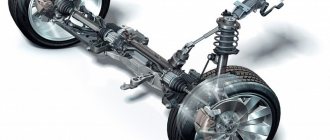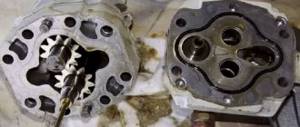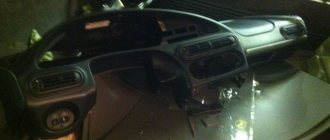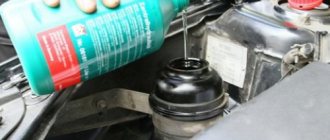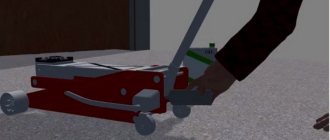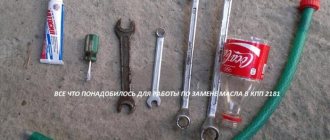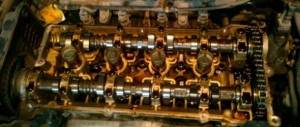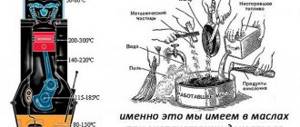Selecting oil for filling into the power steering for a Chevrolet Niva
Hydraulic fluid in a Chevrolet Niva is oil that transmits resistance from the pump to the hydraulic cylinder. This mechanism makes it easier to turn the steering wheel. In addition, the product lubricates car parts and prevents them from wearing out.
Oil circulation through the power steering system occurs through connecting units and hoses. The mixture level is indicated on the expansion tank with MIN and MAX marks. So every motorist should monitor the amount of oil and add it in a timely manner. Otherwise, the system will fail, and its repair will be expensive.
Driving a vehicle without hydraulic fluid will damage the pump, which is an expensive part. As a result, the power steering mechanism will not be able to work. If the Chevrolet Aveo is left without oil in the power steering system, you need to call a tow truck.
If the power steering fails, it is possible to drive the car, but the steering wheel will be difficult to turn.
Driving without hydraulic booster mixture puts you at risk of breaking the pump, which costs a lot of money, as it will run dry. As a result, the part fails prematurely.
Like any other fluid, hydraulic oil loses its properties over time. According to the regulations, replacement is required every 100 thousand km or once every 2-3 years. In addition, the power steering system may fail for other reasons, in which case new oil is added.
Signs that the power steering fluid needs to be replaced:
- Feeling of reverse shocks on the steering wheel. If the pump drive belt is tense or worn, it must be replaced, and then the power steering solution must be changed;
- The steering wheel turns with great effort or, on the contrary, too easily;
- The mixture in the tank has lost its original color;
- Feeling a burning smell;
- Low level of solution in the system;
- Low engine idle speed;
- Dirty tank filter;
- Low operating pressure of the power steering pump;
- Availability of air in power steering.
Frequent use of a Chevrolet Niva car leads to a change in the color of the solution. This is the main reason for changing the power steering oil. You should also not leave the car with the steering wheel turned all the way in the parking lot, as this leads to premature wear of the parts.
The driver must promptly check the power steering system, as well as:
- control the oil level, its color and quality;
- check the tension of the drive belts on the power steering pump;
- check hoses for leaks.
Answers (3)
There are two ways to replace the fluid in the Chevrolet Niva power steering: To partially replace the power steering oil, you will need a syringe with a tube and the oil itself, enough so that at the end of the work it will no longer be dark. Loosen the clamp securing the outlet hose and remove the hose.
To prevent fluid from leaking, plug the hole in the tank fitting and lower the end of the outlet hose into a container for drained fluid. Start the engine and, turning the steering wheel from lock to lock in both directions three or four times, drain the old fluid while adding new fluid.
Repeat the operation until fresh fluid appears from the outlet hose.
The process of changing the oil in the power steering
Replacing power steering fluid in a Chevrolet Niva is carried out in the following ways:
- partial oil change;
- Complete replacement of power steering fluid.
The replacement method is determined depending on the initial state of the liquid in the tank.
In order to partially change the fluid, you will need a syringe, a rubber tube, and 1.5 - 2 liters of oil.
The procedure for partially replacing the fluid in the power steering:
- Unscrew the valve of the power steering plastic expansion tank;
- Draw out the liquid using a syringe and tube;
- Fill in new fluid to the maximum mark;
- Start the engine and turn the steering wheel several times until it stops;
- Stop the engine, pump out the oil and fill in new oil.
The procedure is repeated until the solution that flows out is clean.
Types of liquid used
The main types of liquids that are recommended for use in the Niva are Shell Donax and Ravenol Dextron II D. Previously, to determine what was filled at the factory, the markings “*” were applied to the tank to indicate Shell products and “R” for Ravenol. Recently, the manufacturer has been abandoning such labels, so it is necessary to identify the brand by color.
To replace, the bracket bolt is unscrewed. After which it becomes possible to remove the tank plug.
The tank can be removed from the bracket to drain the liquid into a specially prepared container. After this, you can loosen the clamp of a suitable hose to remove the tank.
To prevent liquid from flowing out, it is necessary to close the hole in the tank fitting, after which you need to lower the end of the hose to drain it into a container to drain the liquid. Then you need to start the engine and turn the steering wheel in different directions 3-4 times until it stops. The old fluid will gradually leave and new fluid will need to be added at the same time. The operation must be repeated until a new one begins to emerge from the outlet hose. The tank is installed in the reverse order. The fluid should be at the top level of the dipstick.
Step-by-step process of draining the old fluid and adding new one
In order for the power steering system to work properly, it is necessary to completely replace the power steering fluid every 3 years. The procedure is as follows:
- Raise the front wheels of the car on a jack so that no pressure is exerted on them;
- Open the hood and secure it;
- Remove the power steering reservoir cap and remove the filter located inside;
- Clean the filter from dirt and deposits using a special product;
- Next, pump out the old solution from the tank using a syringe;
- The hoses are disconnected, the contents are poured into an empty container;
- Start the car engine and turn the steering wheel several times;
- After all the fluid has been removed from the power steering, you can begin to fill in new oil.
After the oil is poured into the expansion tank to the maximum mark, it is necessary to distribute the mixture throughout the entire power steering system. To do this, the steering wheel is turned all the way to the right and left. The oil level will drop at this moment. If necessary, add liquid.
Bleeding the power steering system
To bleed the power steering system on a Niva, you need to set the steering wheel to the middle position and start the engine for a few seconds without turning the steering wheel. After this, you need to turn off the car and turn the steering wheel all the way in any direction.
Then the protective cap is removed from the special valve and, using a wrench, it is turned to bleed any remaining air from the system.
Then you need to turn the steering wheel in the other direction, leaving the air bleed valve open. An air plug and some liquid will come out of it, after which the valve must be closed. If necessary, the mixture is added to the power steering to the maximum mark. Then you need to start the engine and turn the wheel from side to side until it stops. This must be done until air bubbles stop escaping into the tank. If necessary, the mixture is topped up again to the required level.
Changing Power Steering Oil
oil without problems
in
GUR
. All videos on the page.
Now you need to start the engine, turn the steering wheel left and right several times. The pump squeezes out most of the liquid. Rotate the reservoir one more time and gently hold it at the beginning while pouring new fluid. The hose is directed to a waste container. Rinse until a clean, fresh stream comes out of the hose. You can still turn the steering wheel. Now that you see that the fluid is clean, stop the engine and reinstall the hose. Tighten the hose clamp. Replace the reservoir and secure it securely. Last step. Fill the fluid reservoir with the stylus marks attached to the lid. Okay, tighten the cap.
The design of the Niva Chevrolet steering linkage and its features
The Chevy Niva steering linkage is a movable structure of interconnected elements. The main components are:
- Bipod;
- Pendulum arm (steering pendulum);
- Medium thrust;
- Lateral thrust (right and left);
- Steering knuckles.
A bipod is nothing more than an all-metal lever that is mounted on the steering shaft. The left tie rod is pivotally attached to the end of the lever. The middle link serves to transfer force to the right wheel.
For it, the second support point is the steering pendulum, movably mounted in a special bracket. This pendulum plays the role of a second lever, transmitting force to the right steering rod. Steering knuckles do not belong to the trapezoid, but are often considered as part of the steering system and allow a more detailed description of the process of driving a car.
On Shevik, the side rods consist of two parts. They are connected to each other by a split coupling, which has internal left and right threads on different sides. When the clutch rotates, both parts of the side rod converge or diverge, changing the distance from the bipod or pendulum to the steering knuckle. Thus, it is possible to set a certain wheel toe angle. Typically, the part of the side rod that faces the wheel is called the tie rod end.
Absolutely all Niva Chevrolet trapezoid rods have hinges at the ends. The hinge pins are designed for a conical fit and are tightened with nuts when connected. Hinges allow the trapezoid parts to remain movable relative to each other and relative to the car body. Some car enthusiasts are inclined to believe that the elements of the Shevik steering linkage are suitable for the classic Niva and vice versa.
To describe the operation of the entire vehicle control system, it is enough to indicate the main directions of force transmission from the steering wheel. By means of a worm gear, the rotation of the shaft with a gain in force is converted into rotation of the steering bipod. It is simultaneously connected to the left and middle rods. An analogue of a bipod is a pendulum that can rotate freely in the bracket.
When a car turns, the wheels describe a circle of different radii. Provided that the angular velocity on the axle is the same, one wheel will certainly slip. This leads to increased tire wear and poor handling. The solution to the problem comes down to the fact that during a maneuver the steering knuckles must turn at different angles relative to the straight line of motion of the car.
This ratio can be ensured by correct selection of the inclination of the levers, as well as their length. If it is not possible to completely eliminate slipping, then it is necessary to reduce it to a minimum. The wheel alignment angle must be adjusted after any repair work on the trapezoid. It is especially often necessary to change the steering tip, and it is recommended to replace it on both sides at once.
Also interesting: Which Shevik should I choose based on color? Choose - photo for you
Features of operating a Chevrolet Niva car affect the condition of the trapezium elements, so it is important to periodically carry out diagnostics. In order not to lead to the failure of the linkage joints, it is necessary to check the integrity of the protective covers. During the inspection, attention is paid to the presence of cotter pins on the hinge pins, and the absence of deformation or damage to the rods is also checked.
Replacing power steering fluid on a Chevrolet Niva
Power steering fluid performs one of the most important functions of a car - it makes it easier to turn the steering wheel, which in turn allows the driver to adjust the trajectory of movement. However, like any other oil, hydraulic fluid requires timely replacement. We will tell you below how to change the oil in a Chevrolet Niva yourself.
Selecting oil for filling into the power steering for a Chevrolet Niva
Hydraulic fluid in a Chevrolet Niva is oil that transmits resistance from the pump to the hydraulic cylinder. This mechanism makes it easier to turn the steering wheel. In addition, the product lubricates car parts and prevents them from wearing out.
Oil circulation through the power steering system occurs through connecting units and hoses. The mixture level is indicated on the expansion tank with MIN and MAX marks. So every motorist should monitor the amount of oil and add it in a timely manner. Otherwise, the system will fail, and its repair will be expensive.
Driving a vehicle without hydraulic fluid will damage the pump, which is an expensive part. As a result, the power steering mechanism will not be able to work. If the Chevrolet Aveo is left without oil in the power steering system, you need to call a tow truck.
If the power steering fails, it is possible to drive the car, but the steering wheel will be difficult to turn.
Driving without hydraulic booster mixture puts you at risk of breaking the pump, which costs a lot of money, as it will run dry. As a result, the part fails prematurely.
Like any other fluid, hydraulic oil loses its properties over time. According to the regulations, replacement is required every 100 thousand km or once every 2-3 years. In addition, the power steering system may fail for other reasons, in which case new oil is added.
Signs that the power steering fluid needs to be replaced:
- Feeling of reverse shocks on the steering wheel. If the pump drive belt is tense or worn, it must be replaced, and then the power steering solution must be changed;
- The steering wheel turns with great effort or, on the contrary, too easily;
- The mixture in the tank has lost its original color;
- Feeling a burning smell;
- Low level of solution in the system;
- Low engine idle speed;
- Dirty tank filter;
- Low operating pressure of the power steering pump;
- Availability of air in power steering.
Frequent use of a Chevrolet Niva car leads to a change in the color of the solution. This is the main reason for changing the power steering oil. You should also not leave the car with the steering wheel turned all the way in the parking lot, as this leads to premature wear of the parts.
The driver must promptly check the power steering system, as well as:
- control the oil level, its color and quality;
- check the tension of the drive belts on the power steering pump;
- check hoses for leaks.
The process of changing the oil in the power steering
Replacing power steering fluid in a Chevrolet Niva is carried out in the following ways:
- partial oil change;
- Complete replacement of power steering fluid.
The replacement method is determined depending on the initial state of the liquid in the tank.
In order to partially change the fluid, you will need a syringe, a rubber tube, and 1.5 - 2 liters of oil.
The procedure for partially replacing the fluid in the power steering:
- Unscrew the valve of the power steering plastic expansion tank;
- Draw out the liquid using a syringe and tube;
- Fill in new fluid to the maximum mark;
- Start the engine and turn the steering wheel several times until it stops;
- Stop the engine, pump out the oil and fill in new oil.
The procedure is repeated until the solution that flows out is clean.
Step-by-step process of draining the old fluid and adding new one
In order for the power steering system to work properly, it is necessary to completely replace the power steering fluid every 3 years. The procedure is as follows:
- Raise the front wheels of the car on a jack so that no pressure is exerted on them;
- Open the hood and secure it;
- Remove the power steering reservoir cap and remove the filter located inside;
- Clean the filter from dirt and deposits using a special product;
- Next, pump out the old solution from the tank using a syringe;
- The hoses are disconnected, the contents are poured into an empty container;
- Start the car engine and turn the steering wheel several times;
- After all the fluid has been removed from the power steering, you can begin to fill in new oil.
After the oil is poured into the expansion tank to the maximum mark, it is necessary to distribute the mixture throughout the entire power steering system. To do this, the steering wheel is turned all the way to the right and left. The oil level will drop at this moment. If necessary, add liquid.
